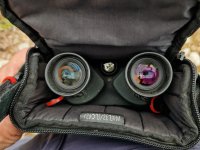Today, while on the field, I noticed something I hadn't realised about my recently repaired Canon IS III 12x36 eyelenses... I have a "David Bowie" special edition...

... each eye piece displays a different colour!!!
Joking aside, I guess this is due to different coatings, because each eyepiece actually belongs to a different Canon device. I recently dropped the binoculars while on holiday, but I was lucky to be traveling towards The Netherlands. There I was again lucky to have the Canon serviced by De Kijkerspecialist, who discovered that the binoculars have landed on one of the eyepieces and it was subsequently broken. But he happened to have an old Canon 12x36 for spare parts. So I got an old eyepiece installed and now I'm more than happy to be able to use the Canon again. But alas, I just discovered the difference in colour/coatings.
So far I haven't noticed anything wrong. Probably there's more difference between my own eyes than there is between the performance of the eyepieces. But just out of curiosity, I wonder how much of a difference can your brain "match"/manage. You know, the same way when you have your binoculars slightly out of alignment but your brain still presents a perfectly nice image (only to give you a terrible headache the moment you put your binoculars down).
How much of a colour/performance/contrast difference can our brain manage before you notice something?

... each eye piece displays a different colour!!!
Joking aside, I guess this is due to different coatings, because each eyepiece actually belongs to a different Canon device. I recently dropped the binoculars while on holiday, but I was lucky to be traveling towards The Netherlands. There I was again lucky to have the Canon serviced by De Kijkerspecialist, who discovered that the binoculars have landed on one of the eyepieces and it was subsequently broken. But he happened to have an old Canon 12x36 for spare parts. So I got an old eyepiece installed and now I'm more than happy to be able to use the Canon again. But alas, I just discovered the difference in colour/coatings.
So far I haven't noticed anything wrong. Probably there's more difference between my own eyes than there is between the performance of the eyepieces. But just out of curiosity, I wonder how much of a difference can your brain "match"/manage. You know, the same way when you have your binoculars slightly out of alignment but your brain still presents a perfectly nice image (only to give you a terrible headache the moment you put your binoculars down).
How much of a colour/performance/contrast difference can our brain manage before you notice something?








